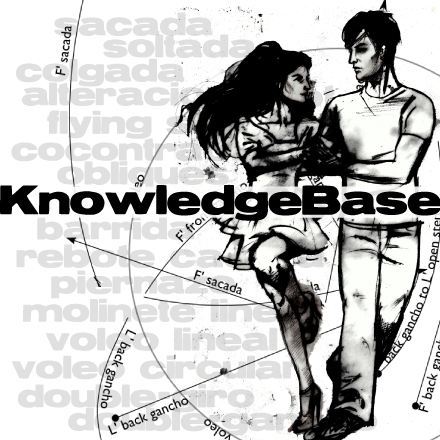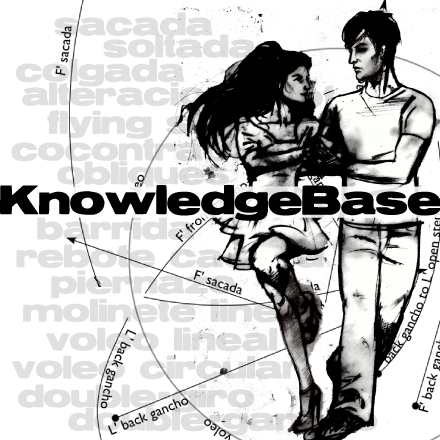A gancho is a voleo, interrupted by the partner’s leg, creating a hook between the legs or around the body (piernazo/castigada).
There are three architectures, each of which has many variations.
- Revel’s gancho to one of the Mark’s legs, with both of his feet on the floor.
- Mark’s gancho to one of the Revel’s legs, with both of her feet on the floor.
- Double-gancho when the two hooked legs are in the air.
Front voleos into a hook are front ganchos (English speakers sometimes use the term ‘wrap’, deprecated here).
Back voleos into a hook are called back ganchos.
Any gancho can be modified to be a piernazo (pro)/castigada (contra) hook around the partner’s body, rather than hooking the leg.
Ganchos can be marked during volcada, but that’s a variation, not the default. Dancers should master the geometry of upright ganchos first.
Maestro El Pulpo developed a method for stringing ganchos together sequentially, based on the principles of barrida. His system is now called Pulpeades.
Base Possibilities
There are 16 Revel’s ganchos possible every time she is on one foot, but 8 of them require the Mark to step backward and are uncomfortable. Below we show the 8 Revel’s ganchos that can be created with the Mark’s front steps. Any of these can be transformed into a double-gancho or done as a Mark’s gancho.
Front ganchos
Back ganchos
Geometry
A gancho is a voleo intersected by a hole in the partner’s body (or in the case of piernazo, by the whole body). A voleo is made of projection + co-contraction. So a gancho is:
hole + projection + co-contraction
Since the Revel is already standing on one foot, the Mark must place his body to intersect the arc of her voleo. He takes his body to hers, he does not pull her onto him!
The geometry has two aspects: Where to place the legs and what happens in the embrace.
The legs:
- For a front gancho, the Mark’s foot will be next to her base leg’s foot, and it can be on either side. His front leg’s knee must be flexed and his back leg’s knee must be extended.
- There are two basic positions of back ganchos.
- Mark in side step so his legs are open to her: In this case, he puts his body very close behind her ass, like spooning. The knee of the leg which will receive the gancho is flexed and the other is extended.
- Mark’s in a crossed (front or back) step. This requires a little more distance from her. Be sure both legs are in external rotation. The front leg will receive the gancho, so its knee must be flexed, with the back leg’s knee extended.
The embrace:
- Front ganchos are done in close embrace: The mark uses vertical shoulder flexion to get close, and the Revel allows him in.
- Back ganchos to the Mark’s open steps: The partners are facing in the same direction, his arms slide around her.
- Back ganchos to the Mark’s crossed steps: The Mark will need lateral shoulder flexion to get behind her in this position.
The best way to discover the correct embrace is to place your legs where they need to be. Make sure the Mark’s back leg has extended knee and both dancers have good arcs. Ask the Revel to put her torso where she is comfortable (and move the Mark’s torso if necessary). Then put the embrace on top of this position. When you know where you want to end up, it’s easier to figure out exactly how the embrace needs to change on the way in.
Be sure that after the change of embrace, both bodies are in their arcs and the triceps are contracted to support the embrace. In some back ganchos, the Revel’s arc will not point at the Mark’s center, but at whatever part of the embrace is in front of her. The triceps are crucial to maintaining connection in any alternative embrace.
Projection
Depending on the situation, the order of operations between hole placement and projection varies. Sometimes there will need to be two projections to direct the Revel’s leg from an existing position into a gancho.
The projection may include some pivot.
- In front ganchos when the Mark’s foot is outside the Revel’s there is no pivot, and the Revel should take care not to add it arbitrarily.
- In back ganchos and piernazos the Mark must allow the revel to move within the embrace so she can maintain external rotation in her base leg. Be aware that her base leg will be rotating in the opposite direction to the projection!
- In piernazo, there needs to be a special projection, which can be created with up or out, prior to the co-contraction into the gancho.
Co-contraction
Ganchos can be marked pro or contra, with or without elasticity. The Revel’s dynamic matches the Mark’s.
- Do not try to avoid touching the mark and do not worry about his groin. He will get it out of the way. If he marks a gancho, he is ready to receive it, and he wants to feel your power moving in sync with his. If you hold back, you are disconnecting, because you are betraying his dynamic and timing.
The co-contraction means that the mark uses his muscles to create power and the Revel mimic this. As always in a voleo, co-contraction in the base leg drives the movement, following by movement of the Revel’s hip (extending for back gancho and adducting for front gancho), and finally knee flexion.
- In a back gancho, the hip extension ensures that you won’t kick him in the shin or leg.
In back gancho, the Revel’s torso needs to tilt forward to accommodate the movement. The Mark must let her move.
Entries
There are many different ways to enter a gancho.
- Moving gancho: The Mark places the hole into the Revel’s step, changing the embrace at the same time.
- He can enter her side step with either leg for a front gancho. The geometry is to step very close to her receiving leg (new base leg), moving into close embrace.
- He can enter her back step with either leg for a back gancho. In these ganchos the partners’ bodies will be shoulder to shoulder (facing the same direction if he uses an open step, facing opposite directions of the gancho is to his crossed step). To get the hole placed well, he needs to use a lot of flexion to get deep into her step and wrap his body around her. Be sure to allow her to continue external rotation and to tilt her torso front.
- He can step over the back leg her front step for a back gancho, using lateral shoulder flexion to adjust the embrace.
- Gancho from a static position. After a cross or from passe, the Mark has more time to set up the geometry, because the Revel is in a static position.
- Gancho from parada. Parada is by far the easiest position from which to mark a gancho. The Revel is standing on both feet and she is still. The mark can set up the geometry for many different ganchos, then put her on one foot and mark the projection and co-contraction. You can turn any sacada into a parada and then go looking for ganchos.
Exits
Nothing about a gancho is arbitrary, including the exit, which has a lot of possibilities. Ganchos can be repeated, completed by returning to the original position, or by exited to any projection or movement. As at any other moment in the dance, the Revel should be ready for projection in any direction, including down under the hole. As in any other moment of the dance, she should not automatically pivot during the exit.
To exit any gancho, the Mark can show the Revel any projection, but he should not initiate the next transfer of weight until he has put his weight onto one foot and released the co-contraction. He can hold the co-contraction to mark sequential ganchos.











